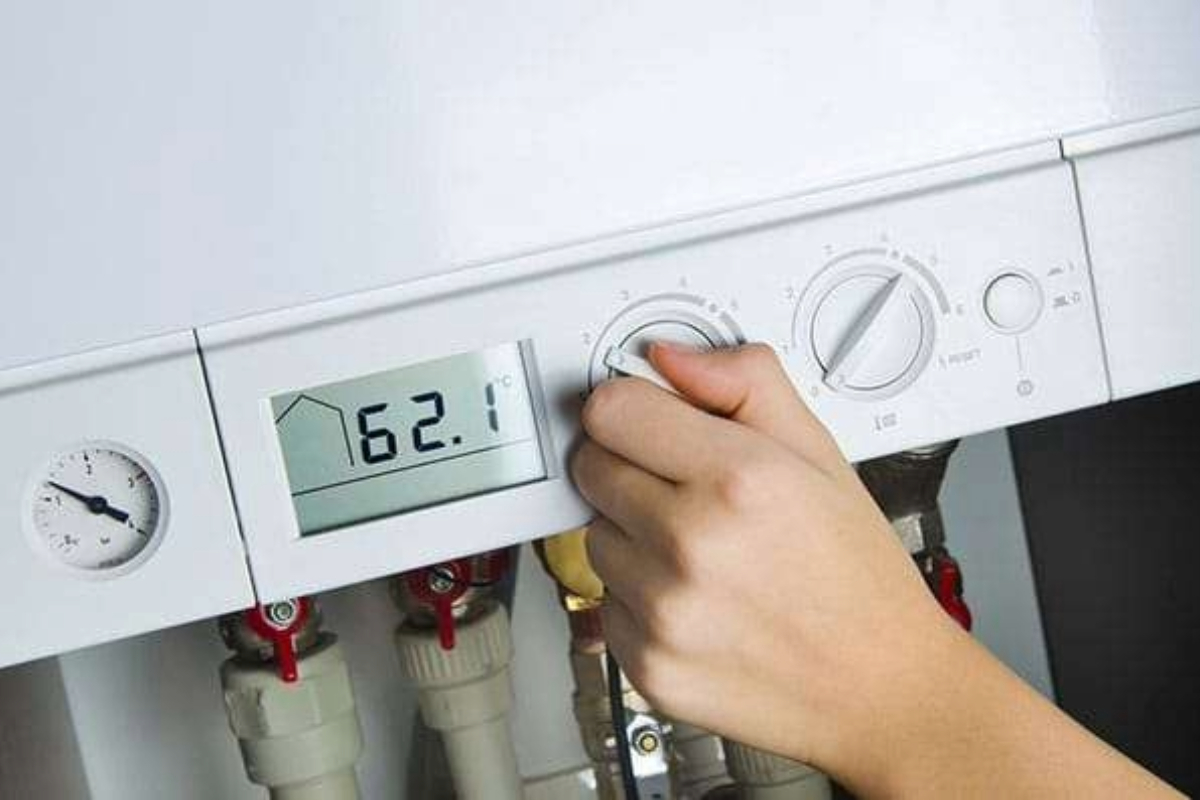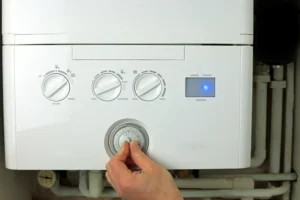Are you trying to figure out how to adjust the pressure on your boiler? This is usually the question many homeowners face. It is particularly true when the boilers get older or maybe need some cleaning. In this guide, we’re going to cover everything you need to know about boiler pressure: what exactly a pressure boiler is, what’s considered a normal pressure level, and whether it’s safe to tackle pressure issues on your own. We’ll break down each topic so you can understand it clearly and feel confident about managing your boiler’s pressure effectively.
A Pressure Boiler
Let’s talk about pressure boilers, which are pretty much the unsung heroes of our home heating systems. Think of a pressure boiler like a kettle, but instead of just making tea, it heats your entire house. The pressure part is key here—it’s what moves the hot water or steam through your radiators or underfloor heating system, keeping you cozy during those chilly months.
Why is the pressure so important in this equation? It’s simple: without the right pressure, your heating system would be as effective as trying to blow up a balloon with a straw. The pressure ensures that hot water or steam circulates efficiently throughout your home, from the basement to the attic. So, when we talk about managing the pressure of your boiler, we’re really talking about making sure your home stays warm and comfortable all year round.
Pros & Cons of Low-Pressure Boiler
Dealing with a low-pressure boiler can be a bit like riding a bike with a flat tire – it’ll get you where you need to go, but it’s not exactly smooth sailing. Let’s see what will be the upside and the downside of a low-pressure boiler.
The Upside of Low Pressure:
- Gentler on the System: Just like a car driven at a lower speed tends to wear out less quickly, a low-pressure boiler can sometimes mean less strain on your heating system. And this can help to extend the life of some of its components.
- Safety Aspect: High pressure in a boiler can be a safety concern (think of an overinflated balloon popping). In this context, a boiler running at a lower pressure might seem safer, as there’s less risk of a pressure-related accident.
The Downside of Low Pressure:
- Inefficient Heating: Low pressure in your boiler is like trying to water a garden with a hose that’s barely trickling. It just doesn’t have the oomph to push heat efficiently through your home. This means some parts of your house might not get as warm as you’d like, and it could take longer to heat up.
- Risk of Shutdown: Think of your boiler like a runner; if the pressure’s too low, it’s like trying to run a race without enough energy. If your boiler pressure drops too low, the system might shut down completely to prevent damage, leaving you in the cold, quite literally.
- Hidden Issues: Low pressure might be a symptom of other problems, like leaks or a failing pump. It’s a bit like having a persistent cough – it might not be serious, but it’s definitely worth checking out to make sure there’s not a bigger issue at play.
What is Normal Pressure on a Boiler?
When we talk about normal pressure in a boiler, think of it like the sweet spot on your thermostat – not too hot, not too cold, but just right. For most home boilers, this ‘just right’ pressure level usually sits between 1 and 1.5 bar. It’s the Goldilocks zone where your boiler operates efficiently and keeps your home comfortably warm.
Imagine the pressure gauge on your boiler as a speedometer. When the needle points somewhere between 1 and 1.5, you’re cruising along smoothly. If it dips below 1, it’s like you’re losing speed and efficiency – your boiler starts to struggle to circulate heat. On the flip side, if the pressure goes above 1.5, it’s like pushing the pedal too hard – your boiler is working more than it needs to, which can lead to wear and tear or even safety issues.
How to Increase the Pressure on a Boiler
Finding that your boiler pressure is a bit on the low side is like realizing your bike’s tires are underinflated. It’s not the end of the world, but it needs a bit of a pump-up to get back to its best. Increasing the pressure on your boiler is usually a straightforward DIY task. Here’s how you can safely give your boiler the boost it needs:
- Check the Pressure Gauge: First, take a look at the pressure gauge. Remember, you’re aiming for that sweet spot between 1 and 1.5 bar.
- Find the Filling Loop: This is the silver or grey hose with a valve at each end, usually found beneath your boiler. It’s the tool you’ll use to add pressure to the system.
- Turn Off the Boiler: Safety first! Make sure your boiler is off and cooled down before you start tinkering.
- Attach the Filling Loop (If Necessary): Some boilers have a detachable filling loop. If yours is one of these, connect it securely.
- Open the Valves: Slowly open both valves on the filling loop. You’ll hear water entering the system – it’s the sound of your boiler’s thirst being quenched.
- Watch the Gauge: Keep an eye on that pressure gauge. As soon as it hits the 1 to 1.5 bar zone, close the valves. Overfilling can lead to different problems, so this part’s a bit like filling a balloon – enough air to float, but not so much that it pops.
- Detach the Filling Loop (If Necessary): If you attached the loop earlier, now’s the time to remove it.
- Turn the Boiler Back On: With the pressure back to normal, you can fire up the boiler again.
- Check for Leaks: After you’ve adjusted the pressure, do a quick check around the boiler for any leaks. It’s like checking around the tap after you’ve fixed a drip.
- Monitor the Pressure: Keep an eye on the pressure over the next few days to ensure it stays within the ideal range.
Is it Dangerous to Fix Pressure by Myself?
Deciding to tackle your boiler’s pressure issues yourself is a bit like choosing to fix a leaky faucet – it can be straightforward, but you need to know your limits. Adjusting the pressure on your boiler isn’t inherently dangerous if you follow the steps carefully and stick to what you’re comfortable with. However, there are certain situations were calling in a professional is definitely the smarter move.
When DIY is Okay:
- Simple Adjustments: If it’s just a matter of tweaking the pressure by using the filling loop, and you’re comfortable with the steps involved, go for it. It’s akin to pumping air into a bicycle tire – you need the right tool and a bit of know-how.
- Familiar Territory: If you’ve adjusted the pressure before without any hiccups, you’re likely good to go. It’s like following a recipe you’ve cooked successfully in the past.
When to Call in the Pros:
- Recurring Pressure Drops: If you find yourself constantly having to increase the boiler pressure, there might be an underlying issue, like a leak. It’s like having to regularly refill your car’s oil – it points to a bigger problem.
- Visible Leaks: If you spot any leaks or signs of damage around your boiler, step away from the DIY. Dealing with leaks often requires professional skills and tools.
- No Experience: If you’ve never adjusted a boiler’s pressure and aren’t confident about the process, it’s best to err on the side of caution. There’s no shame in asking for help – it’s like admitting you can’t fix your car’s engine if you’re not a mechanic.
- Safety Concerns: If you’re ever unsure or uncomfortable at any point, stop. Dealing with a boiler involves gas and hot water, and there’s no room for guesswork when it comes to safety.
The Risks of Self-Repair:
- Damaging the Boiler: Incorrect handling could lead to more serious damage to your boiler, which might be costly to repair.
- Personal Safety: Boilers involve heat, gas, and water under pressure. A misstep could lead to personal injury or damage to your home.
In conclusion, a pressure boiler is the heart of your heating system, pumping warmth throughout your house. It’s essential for keeping things running smoothly and ensuring you’re not left shivering on cold winter nights. So, when we talk about managing the pressure of your boiler, we’re really talking about making sure your home stays warm and comfortable all year round.

